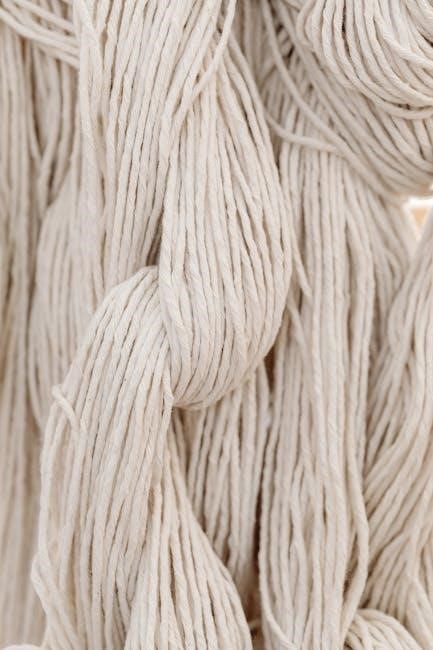The Acme Thread Chart is a comprehensive guide for standardized trapezoidal thread profiles, defined by ASTM B1.5, facilitating accurate selection of thread sizes, pitches, and diameters for various applications.

What are Acme Threads?
Acme threads are a type of trapezoidal screw thread defined by ASTM B1.5, commonly used for linear motion applications due to their durability and ease of manufacturing.
2.1 History of Acme Threads
The Acme thread was first introduced in the early 20th century as a standardized screw thread profile designed to address the limitations of square threads. The development of Acme threads was driven by the need for a more durable and versatile threading system, particularly in industrial machinery. The trapezoidal shape of the Acme thread, defined by a 29-degree angle, was chosen to minimize stress concentrations and improve load-carrying capacity. The ASTM B1.5 standard, which governs Acme threads, was established in the mid-20th century, formalizing their dimensions and applications. Over time, Acme threads have become widely adopted in various industries, including aerospace, automotive, and manufacturing, due to their reliability and ease of production. Today, they remain a cornerstone of linear motion systems, with ongoing advancements in materials and design continuing to expand their utility.
2.2 Advantages of Acme Threads
The Acme thread offers several advantages, making it a preferred choice in many industrial applications. Its trapezoidal profile, defined by a 29-degree angle, provides a larger contact area compared to square threads, enhancing load-carrying capacity and durability. The self-cleaning action of the thread helps prevent debris accumulation, reducing maintenance needs in dirty or industrial environments. Acme threads are also easier to manufacture due to their standardized dimensions, ensuring consistency and interchangeability. Additionally, their versatility allows them to be used in a wide range of applications, from linear motion systems to adjustable mechanisms. The ability to transmit high axial loads while minimizing wear makes Acme threads particularly suitable for heavy-duty machinery. Furthermore, the availability of resources like the Acme Thread Chart PDF simplifies selection and implementation, ensuring engineers can specify the correct thread for their design requirements. These benefits have solidified the Acme thread’s reputation as a reliable and efficient solution in mechanical design.
2.3 Applications of Acme Threads

Acme threads are widely used in various industrial and mechanical applications due to their durability and efficiency. They are commonly found in heavy-duty machinery, such as lifting equipment, jacks, and screw actuators, where high axial loads are present. The trapezoidal profile of Acme threads makes them ideal for linear motion systems, enabling smooth and precise movement. These threads are also utilized in adjustable mechanisms, such as telescoping components and clamping devices, where precise alignment and secure locking are essential. Additionally, Acme threads are employed in construction equipment and automotive parts, where their strength and resistance to wear are advantageous. Their versatility and standardized dimensions, as outlined in the Acme Thread Chart PDF, make them a preferred choice for engineers and manufacturers seeking reliable and efficient solutions for a broad range of applications.
2.4 Key Characteristics of Acme Threads
Acme threads are characterized by their trapezoidal thread profile, which provides a strong and durable connection. They feature a 29-degree thread angle, as defined by ASTM B1.5, making them suitable for high-load applications. One of their key advantages is their self-cleaning property, as the thread design naturally removes contaminants during operation. Acme threads also offer standardized pitch and diameter, ensuring compatibility and ease of use across various systems. Their large core diameter enhances strength, while the rounded root and sharp crest minimize stress concentrations. These threads are ideal for applications requiring smooth motion and low friction. The Acme Thread Chart PDF provides detailed specifications, including thread dimensions and tolerances, ensuring precise engineering and manufacturing. These characteristics make Acme threads a reliable choice for industries such as aerospace, automotive, and heavy machinery.

Understanding the Acme Thread Chart
The Acme Thread Chart serves as a detailed guide for engineers and manufacturers, providing standardized thread dimensions, pitches, and tolerance guidelines. It ensures accurate design and manufacturing of Acme threads.
3.1 What’s Included in the Acme Thread Chart?
The Acme Thread Chart includes detailed specifications for thread sizes, pitches, and diameters, along with tolerance guidelines and dimensional standards. It provides tables listing major diameter, pitch diameter, and minor diameter for various thread sizes. The chart also outlines the trapezoidal thread profile, including the 29° angle and other geometric properties. Additionally, it offers information on thread classes, materials, and applications, ensuring compatibility with ASTM B1.5 standards. Visual representations, such as diagrams and charts, help users interpret complex data efficiently. This comprehensive resource is essential for engineers, manufacturers, and designers working with Acme threads, enabling precise and standardized implementation in machinery and linear motion systems. The chart serves as a one-stop reference for selecting and specifying Acme threads accurately.
3.2 How to Read the Acme Thread Chart
Reading the Acme Thread Chart begins with identifying your specific thread requirements, such as size, pitch, and diameter. Start by locating the thread size on the chart, then cross-reference it with the desired pitch to find the corresponding major, pitch, and minor diameters. Pay attention to tolerance ranges, which are critical for ensuring proper fit and function. The chart typically includes tables with standardized values, making it easier to compare and select the appropriate thread profile. Understanding the chart’s symbols and abbreviations is essential for accurate interpretation. Once you’ve identified the necessary dimensions, you can use the chart to verify compatibility with ASTM B1.5 standards. This systematic approach ensures precise selection and application of Acme threads in various mechanical applications.
3.3 Importance of Using the Acme Thread Chart
The Acme Thread Chart is essential for ensuring accuracy and compliance with standardized thread specifications. It provides a clear reference for selecting the correct thread dimensions, pitches, and tolerances, reducing errors in design and manufacturing. By using the chart, engineers and manufacturers can ensure that components are interchangeable and meet ASTM B1.5 standards. This consistency is critical for maintaining reliability and safety in mechanical systems. Additionally, the chart saves time and resources by eliminating the need for trial-and-error methods. Proper use of the chart also enhances collaboration, as it serves as a universal language for specifying thread requirements. Ultimately, the Acme Thread Chart is a vital tool for achieving precision, efficiency, and compliance in the production of threaded components across various industries.
3.4 How to Access or Download the Acme Thread Chart PDF
To access or download the Acme Thread Chart PDF, visit official standards organizations or engineering resources. The chart is typically available on the ASTM website, as it is defined under ASTM B1.5. You can also find it on engineering forums or manufacturer websites that specialize in threading tools. Ensure you download from reputable sources to guarantee accuracy and compliance with standards.
Additionally, many academic and technical databases offer the chart for free or with a subscription. If you have access to industrial suppliers, they may provide the chart as part of their technical documentation. Always verify the source and version to ensure you have the most up-to-date information for your specific application.

Design Considerations for Acme Threads
Designing Acme threads involves selecting the right thread angle, material, and load capacity. The 29° included angle ensures strength and resistance to wear. Proper material selection and alignment are critical for optimal performance and longevity.
4.1 How to Design Acme Threads
Designing Acme threads begins with understanding the trapezoidal thread profile and its 29° included angle. Start by determining the required thread size, pitch, and diameter using the Acme Thread Chart. Select materials that can withstand the intended load and environmental conditions. Consider lubrication requirements to reduce friction and wear. Ensure proper alignment and clearance during assembly. Use the chart to calculate the lead, pitch diameter, and thread depth. Always verify dimensions against the ASTM B1.5 standard for compliance. Properly designed Acme threads ensure smooth linear motion and optimal load-bearing capacity. Following these steps guarantees a reliable and durable thread design for your application.
4.2 Choosing the Right Materials for Acme Threads
Selecting the appropriate materials for Acme threads is crucial for ensuring durability and performance. Common materials include steel, brass, and plastics, each offering distinct properties. Steel is ideal for high-load applications due to its strength and durability. Brass, being corrosion-resistant, is suitable for harsh environments. Plastics are lightweight and cost-effective, perfect for low-stress uses. Consider factors like load-bearing capacity, environmental conditions, and cost when making your choice. Refer to the Acme Thread Chart for material compatibility with specific thread sizes and pitches. Proper material selection ensures optimal thread performance and longevity in various industrial and mechanical applications.
4.3 Manufacturing Tips for Acme Threads
Manufacturing Acme threads requires precision and adherence to standards. Start by selecting the correct tooling, such as threading bars or inserts, suitable for the specific thread size and pitch. Ensure the material is properly prepared, with a clean, straight, and cylindrical surface. Use the Acme Thread Chart to verify thread dimensions and tolerances. Maintain tight tolerances during machining to ensure proper fit and function. Apply appropriate lubrication to prevent overheating and tool wear. For multi-start threads, use specialized tooling to achieve accurate lead angles. Post-machining, inspect threads for pitch, major, and minor diameters using precision measurement tools. Avoid over-tightening during assembly, as it may damage the threads. Consider applying a protective coating for corrosion resistance, depending on the application environment. Proper manufacturing practices ensure long-term reliability and performance of Acme threads in industrial and mechanical systems.

Installation and Maintenance of Acme Threads
Proper installation and maintenance are critical for Acme threads. Ensure threads are clean and aligned before assembly. Apply recommended lubrication to minimize wear. Regularly inspect for damage or corrosion and replace worn components promptly to maintain optimal performance.
5.1 Installation Tips for Acme Threads
Proper installation of Acme threads is essential for ensuring functionality and longevity. Begin by cleaning the threads to remove dirt or debris, which can interfere with assembly. Use a thread chaser or die to restore thread accuracy if necessary. Ensure the mating surfaces are aligned correctly to prevent misalignment, which can lead to premature wear. Apply a thin, even layer of lubricant to reduce friction during assembly. Tighten the connection gradually, avoiding over-tightening, as this can damage the threads. For screws or nuts, use the correct tools to avoid stripping the threads. In applications involving motion, ensure the threads are properly seated and aligned to support smooth operation. Finally, inspect the installation for any signs of damage or misalignment before putting the assembly into service.

5.2 Lubrication Requirements for Acme Threads
Lubrication is critical for the smooth operation and longevity of Acme threads. Proper lubrication reduces friction, prevents wear, and minimizes the risk of galling or seizing. For most applications, a high-quality petroleum-based lubricant or synthetic grease is recommended. In high-load or high-temperature environments, specialized lubricants with improved thermal stability should be used. Apply the lubricant evenly across the thread surfaces before assembly and periodically during operation, depending on usage conditions. Insufficient lubrication can lead to increased wear and potential thread failure. For dynamic applications, ensure the lubricant is compatible with the materials and operating temperatures. Regular maintenance, including reapplication of lubricant, is essential to maintain optimal performance and extend the service life of Acme threads.
5.3 Maintenance and Care for Acme Threads
Regular maintenance is essential to ensure the longevity and optimal performance of Acme threads. Start by inspecting the threads for signs of wear, contamination, or damage. Clean the threads thoroughly using a soft brush or cloth to remove dirt, debris, or old lubricant. Avoid using harsh chemicals that could damage the material. After cleaning, apply a fresh layer of the recommended lubricant to prevent corrosion and reduce friction. Store Acme threaded components in a dry, cool environment to avoid rust or moisture-related issues. For components in high-wear applications, consider implementing a routine maintenance schedule to monitor thread condition and replace worn parts promptly. Proper handling and storage can significantly extend the service life of Acme threads and ensure reliable performance in their intended applications.

Applications and Case Studies
Acme threads are widely used in machinery, linear motion systems, and industrial equipment. Case studies highlight their effectiveness in applications requiring precise traversal and heavy-duty performance, showcasing real-world success stories.
6.1 Common Applications of Acme Threads
Acme threads are widely utilized in various industrial and mechanical applications due to their durability and efficiency in transmitting motion and force. They are commonly found in lead screws, ball screws, and lifts, where precise linear movement is required. Additionally, Acme threads are used in power transmission systems, jack screws, and actuators, making them integral to heavy-duty machinery. Their trapezoidal profile provides a larger contact area, reducing wear and tear, which is why they are favored in aerospace, automotive, and manufacturing industries. Furthermore, Acme threads are employed in adjusting mechanisms and clamping devices due to their ability to handle high loads without compromising accuracy. The versatility and reliability of Acme threads make them a preferred choice for applications requiring robust and precise linear motion solutions. The Acme Thread Chart serves as a crucial reference for selecting the appropriate thread specifications for these diverse applications.
6.2 Case Studies: Real-World Use of Acme Threads
Acme threads have been successfully implemented in various real-world applications, showcasing their reliability and versatility. In the aerospace industry, Acme threads are used in landing gear systems to ensure smooth and precise movement under heavy loads. Similarly, in the automotive sector, they are integrated into steering mechanisms and adjustable seating systems for enhanced durability and control. A notable case study involves a manufacturing plant that adopted Acme threads for its heavy-duty lifts, significantly reducing maintenance costs and improving operational efficiency. Another example is their use in renewable energy systems, such as wind turbine actuators, where their high load-carrying capacity ensures consistent performance. These applications highlight how Acme threads, when properly specified using the Acme Thread Chart, deliver exceptional results in demanding environments. Their ability to minimize wear and maximize precision makes them a preferred choice across industries.

Troubleshooting Common Issues
Identify issues like thread runout, pitch diameter inaccuracies, or misalignment. Use the Acme Thread Chart to verify specifications and ensure proper thread engagement. Regular lubrication prevents wear and extends service life.
7.1 Identifying Common Problems with Acme Threads
Common issues with Acme threads include thread runout, pitch diameter inaccuracies, and misalignment. These problems often arise from improper manufacturing or installation. Thread runout occurs when the thread profile deviates from the nominal specifications, leading to poor mating. Pitch diameter inaccuracies can cause improper fit and engagement, reducing efficiency. Misalignment during assembly can result in uneven wear and premature failure. Environmental factors, such as insufficient lubrication, can exacerbate these issues. The Acme Thread Chart provides critical measurements, such as thread angles, pitch, and major/minor diameters, to help identify and resolve these problems. Regular inspection and adherence to the chart’s specifications are essential for maintaining optimal performance and longevity of Acme threaded components.
7.2 How to Fix Issues with Acme Threads
Addressing issues with Acme threads often involves recalibrating machinery, replacing worn tools, and ensuring proper alignment. Recalibrate cutting tools to match the Acme Thread Chart specifications for accurate thread profiles. Replace inserts or entire threading tools if wear is detected. Use the chart to verify thread angles, pitch, and diameters, ensuring compliance with ASTM B1.5 standards. Proper lubrication is crucial to prevent galling and wear. Apply a high-performance lubricant suitable for the material and load conditions. For misaligned threads, check and adjust the setup to ensure concentricity. Inspect threaded components regularly and replace them if damage or excessive wear is found. By following these steps, issues can be resolved effectively, maintaining the integrity and functionality of Acme threads in various applications.

Resources and Further Reading
Access the official Acme Thread Chart PDF from engineering resources or manufacturer websites. Explore forums, technical guides, and ASTM standards for detailed insights and practical applications of Acme threads.
8.1 Acme Thread Standards and Specifications
The Acme thread standards are defined by ASTM B1.5, which outlines the dimensions, tolerances, and applications for Acme threads. These specifications ensure consistency and interchangeability in mechanical components. The standard covers basic thread dimensions, including pitch, major diameter, and depth, as well as acceptable tolerances for production. It also provides guidelines for thread forms, such as the 29-degree trapezoidal profile, and class of fit (e.g., Class 2G or 3G). Additionally, the standard addresses material selection and manufacturing practices to ensure durability and performance. For detailed specifications, refer to the Acme Thread Chart PDF, which simplifies the selection process for engineers and manufacturers. By adhering to these standards, professionals can ensure compatibility and reliability in their designs.
8.2 Online Resources for Acme Thread Charts
Accessing the Acme Thread Chart PDF is straightforward through various online resources. Official standards organizations like ASTM provide downloadable versions of the chart, ensuring compliance with industry specifications. Engineering communities and forums often share these charts, offering additional insights and practical applications. Many manufacturers also offer free downloadable resources on their websites, tailored to specific product lines. Online marketplaces like Engineer’s Toolbox and Thread Chart Resources host comprehensive libraries of thread charts, including Acme profiles. Academic institutions and technical schools frequently publish these charts for educational purposes. When sourcing online, ensure the charts are from reputable sources to guarantee accuracy and reliability. These resources are invaluable for engineers, designers, and manufacturers needing precise thread specifications for their projects.


